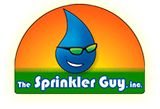- Shut off the water at the irrigation supply valve. This will stop the leak on anything in your irrigation system.
- Use a screw clamp and a sturdy piece of rubber to cover the hole, screwing the clamp tight over the rubber covering the hole.
- Go to the local hardware store and get some plumbers leak putty. This stuff works, but long term it is not the solution as the putty weakens over time and eventually fails.
- Call a professional lawn sprinkler contractor. At The Sprinkler Guy we can handle a burst pipe repair on any type of pipe, so contact us today to get on our schedule.
Sprinkler System Repair

The Sprinkler Guy is a lawn sprinkler repair specialist. “Do one thing, and do it right” Grandpa used to say. There is nothing I haven’t seen in my 30+ years of repairing lawn sprinkler systems. I have hands on experience as well as certification in the landscape industry for irrigation professionals. I have taught these learned skills to many young bucks and a few homeowners along the way. Let The Sprinkler Guy handle all of your irrigation system needs and you’ll have a “guy” for life.
Sprinkler System Repair Services
Burst Pipe Repair – A burst copper, PVC or poly pipe in your lawn sprinkler system is the last thing anyone wants to fix themselves. However there are some quick fixes you can do to slow or stop the flow of a burst pipe, although these are all temporary fixes and a proper burst pipe repair should be completed by a professional. Here are a few suggestions:
Backflow Testing – Backflow testing is a process that is used to test your potable water system, i.e. your drinking water to make sure that your drinking water is not being contaminated by dirty water infiltrating the water supply. Backflow testing is performed by nationally certified testers whom are responsible to uphold state and federal regulations regarding the safety and quality of the public’s drinking water supply. Backflow prevention devices today are technological wonders, but they can and do fail. This is why it is important to have your backflow tested yearly, so contact The Sprinkler Guy today to have your backflow testing completed by a certified, knowledgeable professional.
Backflow Repair – Backflow devices are a part of commercial and residential plumbing systems and are designed to protect the potable water supply, but when they fail a backflow repair specialist should be called in. The reason for this is because backflow devices, which are not necessarily required for single family homes unless they have an irrigation system, are an important part of keeping drinking water safe. Backflow devices are typically found in commercial businesses and multi-family residences. However, when a backflow device is part of your plumbing or irrigation system and you have a problem, backflow repair may be necessary to avoid contaminated water from entering your system.At The Sprinkler Guy, we know backflow repair inside and out so contact us today to schedule an appointment.
Backflow Prevention Assemblies – Backflow prevention assemblies, commonly known as PVB (Pressure Vacuum Breaker), RPA (Reduced Pressure Principle Assembly), DC (Double Check Valve Assembly) and SVB (Spill Proof Vacuum Breaker-usually indoors) are mechanical devices found in a public and private water system. BPA’s allow water to flow in one direction only and prevents water from flowing in the opposite direction through the use of an air gap. The backflow prevention assembly’s only function is to prevent the city water supply, and thereby your drinking water, from contamination. Not all backflow devices are the same, so you will need a certified backflow technician to help you along. The Sprinkler Guy is just that; certified with 30+ years experience and we can assess the degree of hazard, which varies widely between commercial and residential properties, and get you the correct backflow prevention assembly for your situation.
Backflow Parts – Today’s backflow devices are complicated, technological wonders and require yearly testing, repair and occasionally backflow parts in order to repair defective devices. At The Sprinkler Guy we carry backflow parts and backflow devices for Watts, Febco, Wilkins, Ames and many other backflow device brands. We are certified backflow testing and repair specialists and we carry many other backflow repair parts so contact us today for all your backflow needs.
Install A Backflow Preventer – A backflow preventer is an important part of a lawn irrigation system and there is good reason to install a backflow preventer. It keeps contaminated water, such as fertilizers and pesticides from entering drinking water lines. A new backflow preventer costs between $600-$750 for a residential property and $1500-$6000 for larger commercial properties. The size and age of your system also affects the cost because older systems may require more upgraded parts to match current codes. Another factor is larger yards or properties with large elevation gains or drops which may require a more expensive preventer. The Sprinkler Guy can install a backflow preventer, check it yearly and help keep your home or business safe and up to code.
RPA Backflow Preventer – A Reduced Pressure Principle Assembly (RPA) is a mechanical backflow preventer that consists of two independently acting, spring-loaded check valves with mechanically independent, hydraulically operated, spring-loaded pressure differential relief valves. It includes shutoff valves at each end of the assembly and is equipped with test cocks. An RPA is effective against both backpressure backflow and backsiphonage. RPA’s are used to protect against contamination in water systems such as to irrigation systems, boiler feeds, water lines and other installations requiring the highest level of mechanical protection. RPA’s must be installed above ground and should have a minimum clearance of 12″ from bottom of relief valve. When installing, allowances should be made for good access to the device for repairs and testing. The Sprinkler Guy offers RPA backflow preventer testing, maintenance and repair so contact us today to schedule an appointment.
Dual Check Backflow Preventer – A Dual Check Backflow Preventer or DCVA is a mechanical backflow preventer that consists of two independently acting, spring-loaded check valves. It includes shutoff valves at each end of the assembly and is equipped with test cocks. A DC is effective against backpressure backflow and backsiphonage but should be used to isolate only non health hazards. Double check assemblies are typically used to prevent backflow of pollutants that are objectionable but not toxic. These can be installed under continuous pressure service and may be subjected to backpressure. Double checks can be used on sprinkler irrigation systems and fire protection systems as well as other systems requiring protection. The Sprinkler Guy is certified in testing double check assemblies as well as all other backflow devices so contact us today to schedule an appointment.
Pressure Vacuum Breaker – A Pressure Vacuum Breaker or PVB is a mechanical backflow preventer that consists of an independently acting, spring-loaded check valve and an independently acting, spring-loaded, air inlet valve on the discharge side of the check valve. It includes shutoff valves at each end of the assembly and is equipped with test cocks. A PVB is only effective against backsiphonage and can be used to protect against health hazard and non-health hazard backsiphonage conditions in industrial plants, cooling towers, laboratories, laundromats, swimming pools and lawn sprinkler systems. The Sprinkler Guy is a certified Pressure Vacuum Breaker specialist and can handle repairs and replacement so contact us today to schedule an appointment.
Vertical Backflow Preventer – A Vertical Backflow Preventer or VBP is a mechanical backflow preventer that consists of two independently acting, spring-loaded check valves. It includes shutoff valves at each end of the assembly and is equipped with test cocks. A VBP is effective against backpressure backflow and backsiphonage. VBP’s are used to protect against contamination in water systems such as to irrigation systems, boiler feeds, water lines and other installations requiring the highest level of mechanical protection. VBP’s must be installed above ground and should have a minimum clearance of 12″ from bottom of relief valve. When installing, allowances should be made for good access to the device for repairs and testing. The Sprinkler Guy offers Vertical Backflow Preventer testing, maintenance and repair so contact us today to schedule an appointment.
Cross Connection Testing – Any actual or potential connection or structural arrangement between a public or a consumer’s potable water system and any other source or system through which it is possible to introduce into any part of the potable system any used water, industrial fluid, gas, or substance other than the intended potable water with which the system is supplied is required to have Cross-Connection testing performed yearly. There are two types of cross connection: a direct cross-connection is a cross-connection which is subject to both back siphonage and back pressure and an indirect cross connection is a cross connection which is subject to back siphonage only. At The Sprinkler Guy we provide cross connection testing and repair and we offer 30+ years of experience to help answer your questions and keep you and your business in compliance with all state and local regulations.
Cross Connection Repair – A cross connection is a point in a plumbing system where the potable water supply is connected to a non-potable source. Briefly, a cross connection exists whenever the drinking water system is or could be connected to any non-potable source (plumbing fixture, equipment used in any plumbing system). Pollutants or contaminants can enter the safe drinking water system through uncontrolled cross connections when backflow occurs. When this occurs a cross connection repair is necessary and here at The Sprinkler Guy we know cross connection repairs, and with 30+ years of experience we can help you stay up to date and in compliance with all state and local regulations.
Reduced Water Use – With water prices going up along with our awareness of water scarcity, we are often asked how to decrease water used for irrigation. Here are a few of our tactics for reducing water use by an irrigation system:
Reduce Site Water Requirements:
One of the simplest ways to decrease water used for irrigation is to limit the turf areas that require a high amount of water. Less is more we like to say.
Improve Distribution Uniformity (DU):
Make sure that your sprinkler heads and nozzles are all spraying correctly and hitting the areas they are supposed to hit and with the proper amount of water. Why water the sidewalk- the last we checked concrete doesn’t grow.
Use Pressure Regulation:
Pressure regulation helps ensure that sprinklers are operating at the optimal level.
Convert to Drip Irrigation:
Convert sprinklers (within plant beds) over to drip irrigation so water has less of a chance to evaporate and/or runoff.
Use Smart Controllers:
Smart controllers determine the watering durations and frequencies on a daily basis based on the real-time weather conditions.
At The Sprinkler Guy we know how to reduce water use in your irrigation system, so contact us today to schedule an audit and find out how you can lower your water bills.

